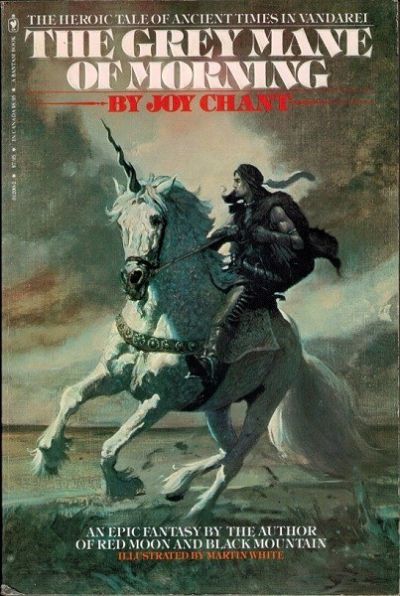Rise Unfraid
The Grey Mane of Morning (House of Kendreth, volume 2)
By Joy Chant

28 Jul, 2024
1977’s The Grey Mane of Morning is the second volume in Joy Chant’s House of Kendreth secondary-universe fantasy trilogy. Alternatively, The Grey Mane of Morning is a prequel set long before the events of Red Moon and Black Mountain.
Once the Khentorei, Gentle People of the Plains, were pathetic cave-dwelling savages. Driven from their former homes by the technologically superior Golden Ones, the Khentorei embraced the god Kem’nanh, domesticated the great Horned Horses, and made the plains their home.
Khentorei lives are not long lives, but they are for the most part enjoyable. The tribes wander as they please, following traditional ways, in an almost timeless existence. There is no need for history if nothing changes.
There is just one flaw in this paradise: the Golden Ones.
The Golden Ones still live in their fortified stockades. The Golden Ones still possess arts like metal working of which the stone-age Khentorei know nothing. The Golden Ones are armed with weapons better than those of the Khentorei and unlike the Khentorei, the Golden Ones’ weapons are designed for war. Even Golden One stature works in their favor. The Golden Ones tower over the plains folk.
Consequently, the Golden Ones feel quite secure in their relationship with the nomads. As far as the Golden Ones are concerned, the Khentorei are not really people. Rather, they are domestic animals, harvested whenever a group comes too close to a Golden One stockade. Anything a Khentorei has that a Golden One covets is confiscated. Sometimes this includes Khentorei themselves.
Madol of Mald sees beautiful Nai and decides she must be his. He thinks nothing of simply dragging Nai away from her tribe. Nai’s brother Mor’anh and Nai’s would-be husband Hran are both upset by Nai’s kidnapping, but this is of little concern to Madol. What can mere herdsmen do against the might of the Golden People?
Madol’s whim triggers a rapid deterioration in Golden People – Khentorei relations. Tribal elders are not inclined to protest the actions of people they take for demi-gods. Young people like Mor’anh and Hran are too angry to be cautious. The Golden People respond to tribal disquiet with treacherous and homicidal rebukes. These only inflame Khentorei outrage.
The Golden People have miscalculated. Their confrontations with the nomads reveal that the Golden Ones are not demi-gods, only people armed with better weapons. Furthermore, the Golden Ones have no cavalry to match warriors on Horned Horses. Worse from a Golden One perspective, the god Kem’nanh from time-to-time acts through chosen agents. In this generation, that agent is Mor’ahn.
Thanks to a visitor in the not-too-distant past, Mor’anh has a notion that Khentorei can obtain metal weapons equal to or superior to Golden One weapons. The People of the Cities are to the Golden People as the Golden Ones are to the Khentorei. Alas, the Cities are far from the plains.
Travelling across hundreds of miles and convincing strangers to arm him will be a daunting task. Is even Mor’anh up to the challenge?
~oOo~
The Khentorei do not delineate roles along gender lines to the extent that other cultures do. Part of the reason is because Khentorei women have an innate ability to control whether or not they get pregnant1. It’s not uncommon for secondary fantasy worlds to feature something like that (or failing an innate ability, some other form of convenient birth control.). I could easily do a piece for ReacTor on this. I wonder if any examples would pre-date the Pill?
Not only did Chant make the unusual decision to follow up her first novel with a prequel set in the distant past of the first novel, her second novel differs from the first in a number of important ways.
Red Moon and Black Mountain is quite Narnia-esque, with children from our world present to provide a modern perspective. Not so Grey Mane. There are no otherworldly visitors here, only people who interpret events through parochial lenses.
Also, despite Kem’nanh’s role, the stakes are quite local. There is no grand villainous sorcerer plotting to conquer the world. The conflict is between one small group of opportunistic conquerors — themselves small potatoes compared to contemporaneous civilizations — preying on one specific community of nomads. True, the Golden People might later be seen as having transformed the Khentorei from stone-age primitives to the closest thing this continent will have to unicorn-riding Cossacks but within the confines of the novel, the outcome is quite local.
While Chant clearly has great affection for her nomads and imbues them with laudable qualities, Chant does not have any particular illusions about their lifestyle. The plains are unforgiving. By the standards of their contemporaries, the Khentorei are impoverished and short-lived.
The narrative is curiously linear given the novel’s length (only 300-odd pages but in a very small font). Nevertheless, the tale entertains. It seems rather surprising, therefore, that not only is Grey Mane out of print, it seems to have fallen out of print within five years of publication. How odd. I remember the series as being far more popular than its publication record suggests it actually was.
The Grey Mane of Morning is out of print. Given the huge print-runs of the 1970s, copies should be easy to find.
1: The Golden Ones do not have this knack and are frustrated to discover that Khentorei women do. The Golden One solution for unwanted babies is to expose them. This is relevant to the plot.
